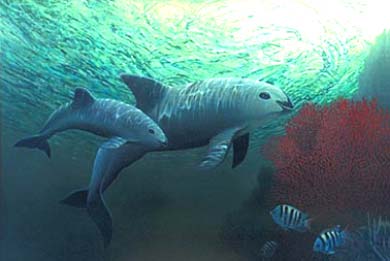
Vaquitas are the smallest and most endangered species of the cetacean order and are found only in the northern end of the Gulf of California. The vaquita is stocky and has a classic porpoise shape. The species is distinguishable by the dark rings surrounding their eyes, patches on their lips, and a line that extends from their dorsal fins to their mouth. Their back is a dark grey that fades to a white underside. As vaquitas mature, the shades of grey lighten. [7]Female vaquitas tend to grow to be a bit larger than the male. Females usually end up at a length of 140.6 cm, compared to the males 134.9 cm. The lifespan, pattern of growth, seasonal reproduction, and testis size of the vaquita are all similar to that of the harbour porpoise.[8] Theflippers are proportionately larger than other porpoises' and the fin is taller and more falcate. The skull is smaller and the rostrum is shorter and broader than in other members of the genus. The females are discernible from the males due to their larger size.[7]
Behavior[edit]
Vaquitas use high-pitched sounds to communicate with one another and for echolocation to navigate through their habitats. They generally seem to feed and swim at a leisurely pace. Vaquitas avoid all boats and are very evasive. They rise to breathe with a slow forward motion and then disappear quickly. This lack of activity at the surface makes them difficult to observe.[9] Vaquitas are usually alone unless they are accompanied by a calf,[10] meaning that they are less social than other dolphin species. They may also be more competitive during mating season.[11] They are the only species belonging to the porpoise family that live in warm waters.[12] Vaquitas are nonselective predators.[13]